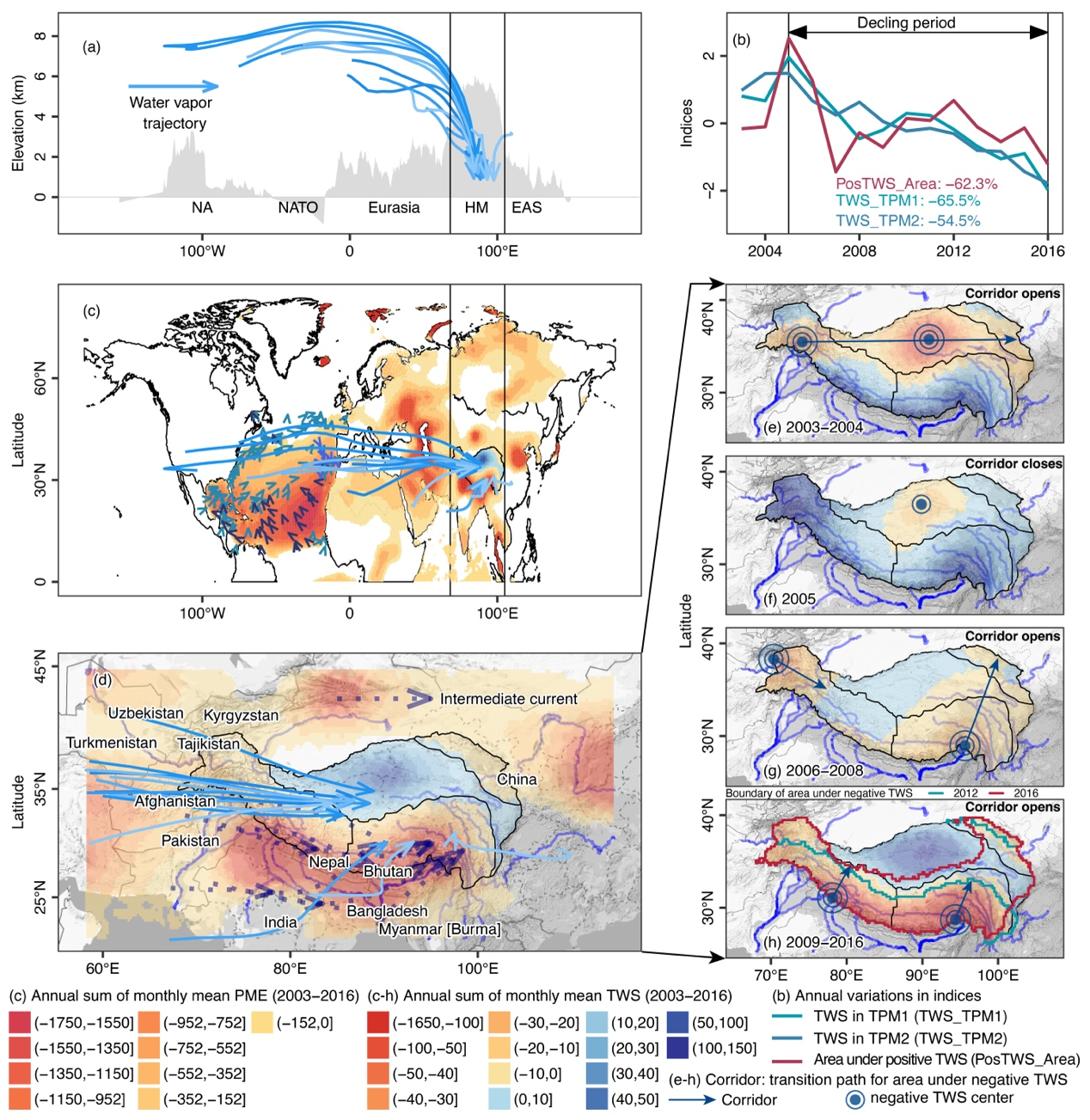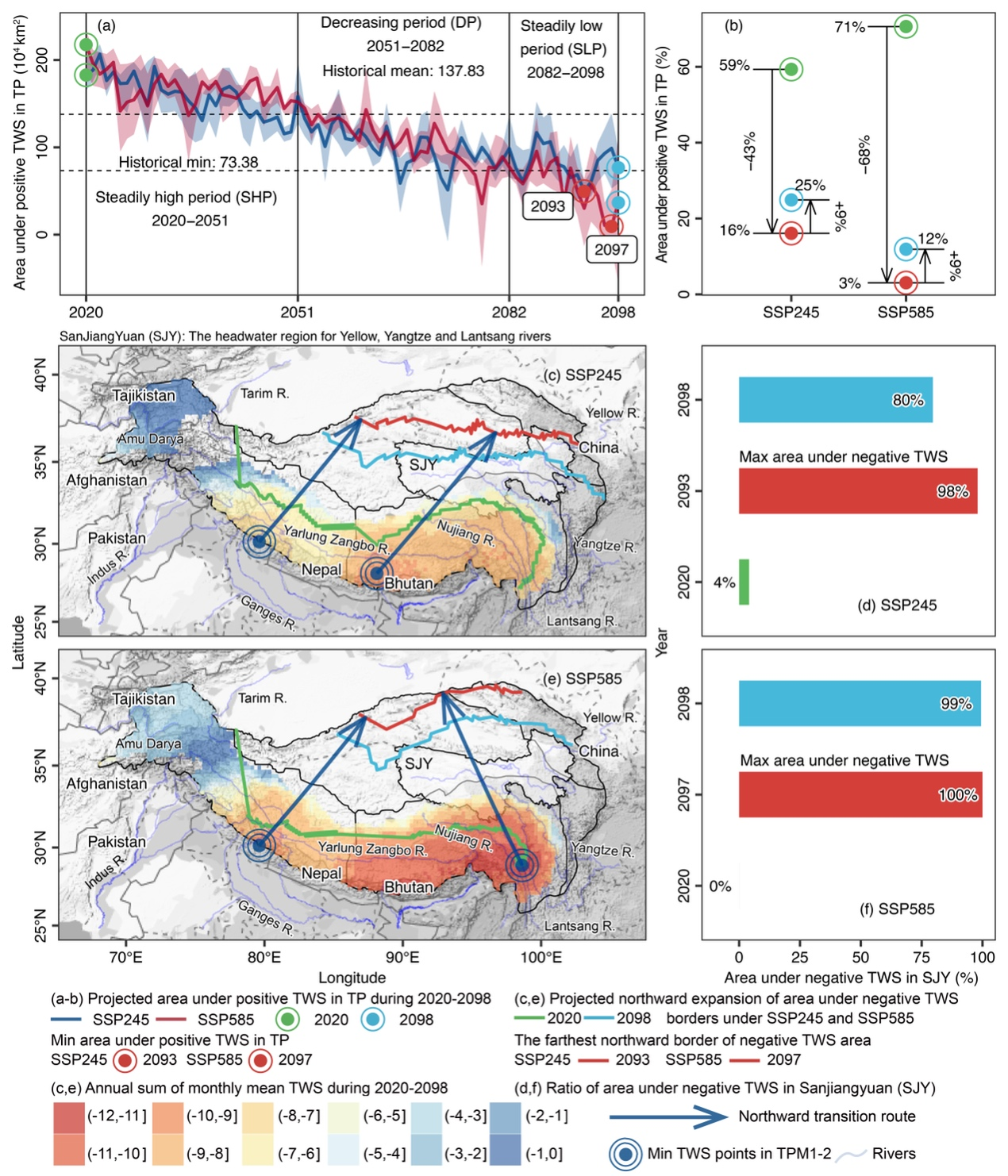On March 1, 2023, Prof. Zhang Qiang and his group working in Advanced Interdisciplinary Institute of Environment and Ecology, Beijing Normal University at Zhuhai (BNU Zhuhai), published their findings titled "Oceanic climate changes threaten the sustainability of Asia's water tower" in Nature (DOI: 10.1038/s41586-022-05643-8) presenting their critical progress in the research on the water cycle of the Asia’s water tower.
Unprecedented changes have taken place in the water resource system of the Asia’s water tower area. However, the evolution of terrestrial water storage on the Qinghai-Tibet Plateau has significant spatial heterogeneity, and the mechanism of water cycle and relevant atmospheric dynamics mechanism behind it are still unclear. Previous studies have found that the westerly belt and the Indian monsoon recharge water vapor to the high mountains of Asia, and the decrease in Himalayan precipitation and the increase in precipitation over thePamirs observed from 1979 to 2010 were attributed to the weakening Indian monsoon and the strengthening westerly belt, respectively. Itis worth noting that, in addition to the function of water vapor transport, atmospheric circulation can still serve as the carrier of meteorological drought transmission in water vapor sources. This scientific understanding has been published in Nature Communications in 2022 by Prof. Zhang Qiang and his group. Low-latitude Atlantic Ocean contributed to terrestrial water storage depletion across Eurasia. At the same time, existing studies have also considered the mid-latitude westerlies as one of the potential driving factors for the decline of glaciers in the Asian high mountains. However, it is worth noting that only the central region of the Qinghai-Tibet Plateau has shown a significant increase in terrestrial water storage. Given that only limited water vapor reaches the central Tibetan Plateau, Prof. Qiang Zhang and his group proposed a scientific hypothesis that the increase in terrestrial water storage in the central Tibetan Plateau could be attributed to the blocking effect of the Asian Alpine region on the PME (precipitation minus evaporation) deficit transported by the westerly belt. As the melting of glaciers is the main factor for the change in terrestrial water storage in high mountainous areas of Asia, the research team believes that the melting of glaciers and the change of snow cover in high mountainous areas of Asia may have changed the thermodynamic conditions of high mountainous areas in Asia, which in turn led to the reduction of the blocking effect of high mountainous areas in Asia.
Because of its great significance to the protection of water resources in the Qinghai-Tibet Plateau and its surrounding areas, the Asia’s water tower has attracted pervasive attention from scholars at home and abroad, and has also achieved a series of important research results. Based on the existing important researches, the following issues need to be further addressed, namely: the atmospheric dynamics mechanism behind the spatial heterogeneity of the evolution of terrestrial water storage on the Tibetan Plateau is still unclear; The driving factors behind the sudden drop of the terrestrial water storage after 2013 are still unclear. Further research and clarification of the above two unresolved scientific issues have great theoretical and practical significance for in-depth understanding of the spatio-temporal characteristics and driving mechanism of Asian water towers' terrestrial water storage, and for exploring the sustainability of Asian water towers.
On the basis of in-depth analysis of the water vapor cycle process of the Asia’s water tower, Professor Zhang Qiang and his group comprehensively quantified the atmospheric circulation process of the Qinghai-Tibet Plateau, and systematically solved the unsolved challenging issues in the research of the Asia’s water tower. The research team comprehensively discussed and elucidated the spatial heterogeneity of the evolution of terrestrial water storage on the Qinghai-Tibet Plateau and the underlying atmospheric dynamics (Fig. 1). The results of the study show that the decline of terrestrial water storage in the south of the Tibetan Plateau is mainly affected by the PME deficit from the southeastern North Atlantic transported by the westerly belt. In addition, the research team also confirmed through dynamic simulation that the Asian high mountain area prevented the further spread of the PME deficit to the central Tibetan Plateau, which in turn triggered an increase in terrestrial water storage in the central Tibetan Plateau.

Figure 1 Spatial heterogeneity and driving mechanism of terrestrial water storage on the Qinghai-Tibet Plateau
The research team confirmed that the sudden decline in terrestrial water storage in the central Qinghai-Tibet Plateau after 2013 was attributed to the weakening of the arresting effect of the Asian high mountains (Figure 2), and found that the melting of ice and snow in the Asian high mountains caused by marine climate change was associated with the loss of terrestrial water storage. This terrestrial water storage deficit changes the thermodynamic conditions in the region and further weakens the blocking effect of the Asian high mountains on the PME deficit from the ocean. This has led to the continuous expansion of the terrestrial water storage deficit of the Tibetan Plateau from the southern mountainous area to the north since 2009, which in turn triggered a sudden decline in the terrestrial water storage of the central Tibetan Plateau after 2013.

Figure 2 The mechanism of the northward shift of terrestrial water storage deficit in the southern mountainous area of the Qinghai-Tibet Plateau
In addition, the research team further predicted the areas with terrestrial water storage deficit on the Qinghai-Tibet Plateau in the future (Figure 3). The prediction model has been verified by historical data, and the accuracy rate is as high as 75% to 91%. Projections under different climate scenarios show that the Qinghai-Tibet Plateau is expected to be affected by terrestrial water storage deficit by the end of this century as high as 84% (SSP245) or 97% (SSP585). This will seriously threaten the sustainability of the water supply of major rivers in Asia, which in turn may exacerbate the water crisis in downstream regions.

Figure 3 Prediction of the northward shift of terrestrial water storage deficit in the southern mountainous area of the Qinghai-Tibet Plateau under different emission scenarios in the future
Professor Zhang Qiang working in the Advanced Interdisciplinary Institute of Environment and Ecology, Beijing Normal University, China is the first and corresponding author. Mr. Zexi Shen, a doctoral candidate in the Faculty of Geographical Sciences, Beijing Normal University, is the co-first/corresponding author of the paper. Coauthors are also Associate Professor Yadu Pokhrel from Michigan State University, Professor Daniel Farinotti from ETH Zurich, Professor Vijay P. Singh from Texas A&M University, Professor Xu Chongyu from the University of Oslo, Senior Engineer Wu Wenhuan from Beijing Institute of Geology of Nuclear Industry, Gang Wang, a doctoral candidate from Faculty of Geographical Sciences, Beijing Normal University. The research is mainly supported by the National Key R&D Program (No. 2019YFA0606900), the National Natural Science Foundation of China Major Research Project (No. 42041006), the Xinjiang Uygur Autonomous Region Water Resources and Ecological Water Conservancy Engineering Research Center (Academician Expert Workstation) Project (No.: 2020.A-003) and the US National Natural Science Foundation of China (No. 1752729).


